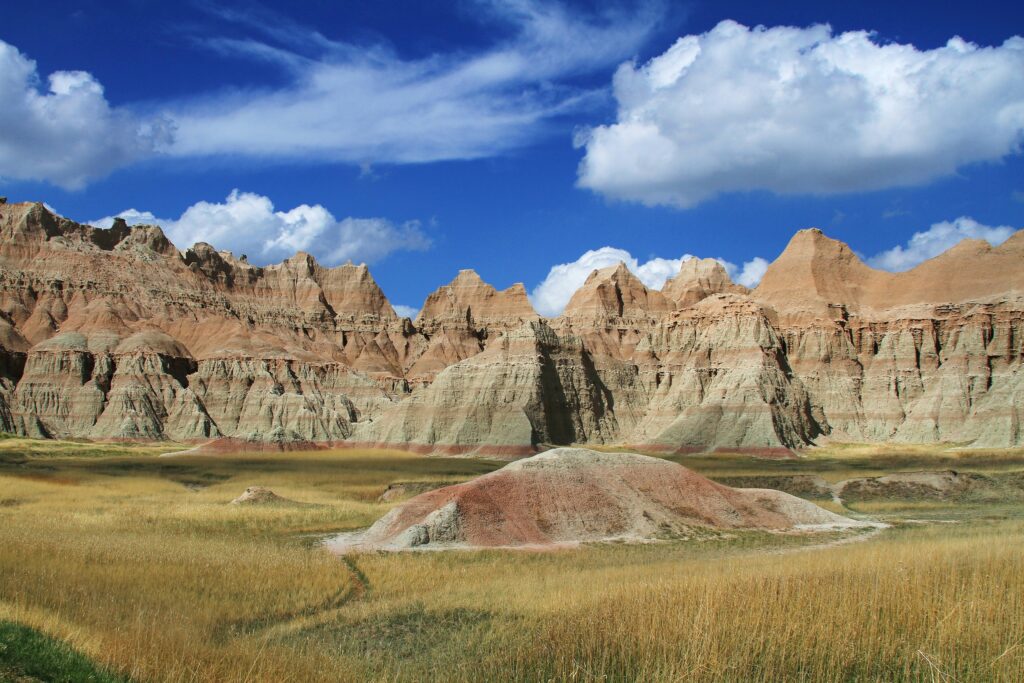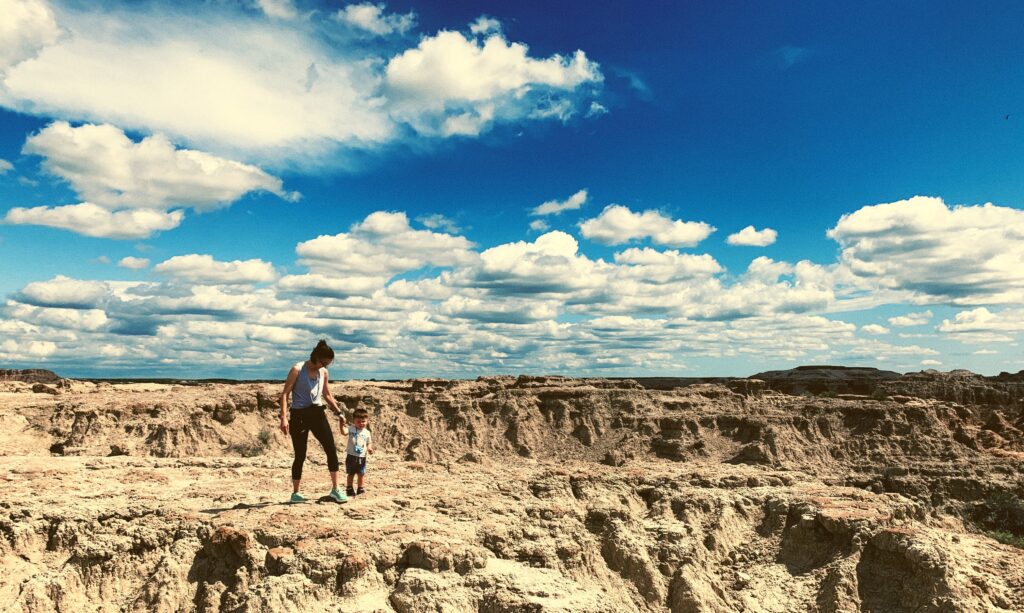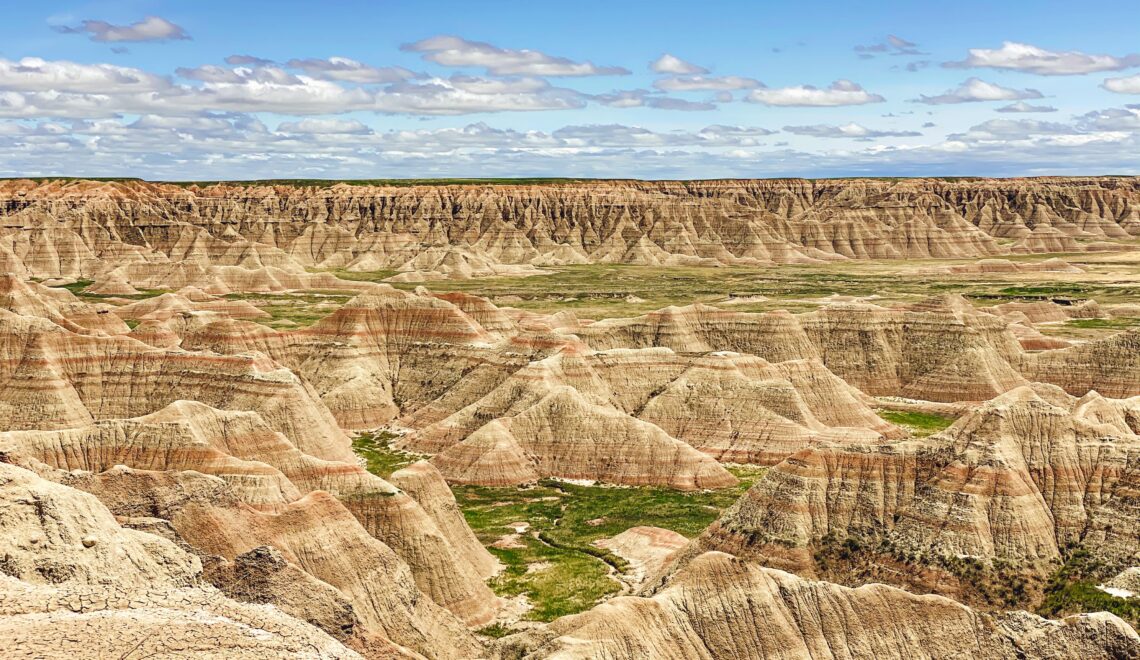The Paleontologist’s Playground: Fossil Hunting in the Badlands
Welcome to Badlands National Park, where beneath the rugged beauty of the landscape lies a hidden world of ancient wonders. This park in South Dakota is renowned as a paleontologist’s dream come true. Its unique geology, characterized by eroded buttes, deep canyons, and exposed sedimentary layers, has unveiled a wealth of fossils dating back millions of years. Continue reading to learn more about fossil hunting in the badlands!
Some posts on this site contain affiliate links, meaning if you book or buy something through one of these links, I may earn a small commission at no extra cost to you.
What to See in Badlands National Park

Before you embark on your fossil-hunting adventure, it’s worth knowing what to look for. While the Badlands are famous for their fossilized remains of prehistoric creatures, you’ll mainly encounter fossils of three distinct periods: the Oligocene, Miocene, and Pliocene epochs. Keep an eye out for the remains of ancient horses, camels, and rhinoceros-like creatures as you explore the park.
Beyond the fossils, Badlands is renowned for its dramatic geological formations. Towering spires, deep canyons, and sharply eroded buttes dominate the landscape. Iconic formations like the Castle, White Butte, and Yellow Mounds offer not only fantastic photo opportunities but also insight into the forces of erosion and deposition that have sculpted the park over millions of years.
Discovering Dinosaur Fossils in Badlands
Among the remarkable fossil finds in Badlands National Park, dinosaur fossils stand out as some of the most captivating and scientifically significant. The park has yielded a treasure trove of dinosaur remains that provide invaluable insights into the prehistoric world. Here, we delve into the world of dinosaur fossils found in Badlands:
- Dinosaur Diversity: Badlands National Park has revealed a rich tapestry of dinosaur species that once roamed this ancient landscape. Among the notable discoveries are fossils of horned dinosaurs like the Triceratops, the ferocious Tyrannosaurus Rex, the long-necked sauropods, and the armored ankylosaurs. These fossils paint a vivid picture of the diverse ecosystems that thrived here during the Late Cretaceous period, around 66 million years ago.
- Paleontological Expeditions: Over the years, paleontologists have conducted extensive excavations within the park to uncover dinosaur fossils. Some of these digs have led to remarkable finds, including nearly complete dinosaur skeletons. Visitors with a keen interest in paleontology might be fortunate enough to witness ongoing excavations or learn about past discoveries through interpretive programs and displays.
- Fossil Preparation Labs: The park’s commitment to paleontological research is evident in the Fossil Preparation Labs, which are open to the public. Here, you can watch skilled paleontologists meticulously clean, restore, and study dinosaur fossils. It’s a fascinating behind-the-scenes look at the scientific process involved in bringing these ancient creatures back to life, at least in our imaginations.
- Educational Programs: Badlands National Park offers a range of educational programs and ranger-led talks that delve into the world of dinosaurs. These programs cover topics such as the park’s geological history, the lives of dinosaurs, and the methods used by paleontologists to unearth and study fossils. They provide an excellent opportunity for visitors of all ages to deepen their understanding of the park’s prehistoric past.
- Museum Exhibits: The visitor centers within the park often feature museum exhibits showcasing dinosaur fossils and the scientific discoveries made in Badlands. These exhibits provide a chance to see fossils up close and learn about the fascinating stories they tell about Earth’s history.
The Fossil Trail
For those eager to start their fossil-hunting journey, the Fossil Trail in Badlands National Park is the ideal place to begin. This interpretive trail is located near the Ben Reifel Visitor Center and offers a guided tour through the park’s fascinating geological history. Along the way, you’ll encounter informative signs and displays that shed light on the creatures that once roamed this area. It’s a fantastic introduction to the world of fossils.
Essentials for Your Paleontology Adventure
Gearing up for a fossil hunting adventure can be a thrilling experience. This section offers a valuable list of must-have equipment and handy guidelines to make your prehistoric exploration both safe and successful.
Fossil Hunting Hotspots

Badlands National Park offers a plethora of fossil-hunting hotspots, each with its own unique geological and paleontological significance. Here, we delve deeper into some of these remarkable areas where you’re likely to uncover ancient treasures:
- Conata Basin: Located near the Conata Picnic Area, the Conata Basin is a prime destination for fossil enthusiasts. This area is renowned for its rich Oligocene and Miocene fossil deposits. While exploring, keep an eye out for fossils of ancient mammals, including horses, camels, and rhinoceros-like creatures. The basin’s exposed sedimentary layers make it an ideal spot for fossil hunting.
- Yellow Mounds: Aptly named for the distinctive yellow hue of the exposed soil, the Yellow Mounds area is another must-visit location for fossil hunters. This area boasts an abundance of Oligocene fossils, including those of the famous “Titanotheres” or “Brontotheres.” These prehistoric creatures, resembling large, ancient relatives of today’s horses, once roamed the Badlands. Scan the slopes and ground for small fossils and fragments that might lead you to significant discoveries.
- Cliff Shelf Nature Trail: The Cliff Shelf Nature Trail offers a unique perspective on the Badlands’ geological history and provides opportunities for fossil hunting. Along the trail, you’ll encounter informative signs that introduce you to the park’s ancient residents. Keep an eye out for fossilized bone fragments and small fossils embedded in the rock formations. This trail is an excellent starting point for novice fossil hunters.
- Northeastern Area: While the park’s western regions are more famous for fossils, the northeastern area, near the Cedar Pass Campground, also holds fossil treasures. Explore the eroded hillsides and gullies, and you may stumble upon fossilized remnants of ancient mammals and marine creatures that once inhabited this diverse ecosystem.
- South Unit Overlooks: Some of the best fossil finds occur simply by taking in the breathtaking vistas from the park’s overlooks. As you peer out over the layered canyons and buttes, keep a sharp eye for fossils exposed on the surfaces below. Sometimes, a keen observation can lead to the discovery of fossils right from the comfort of a viewpoint.
Discovering a Fossil: What to Do
First and foremost, it’s important to remember that removing fossils from national parks is strictly prohibited by law. Fossils are considered valuable scientific and cultural resources, and their removal can harm the park’s delicate ecosystem and historical record. Therefore, if you find a fossil, the best course of action is to leave it exactly where you found it.
Here are some steps to follow when you come across a fossil in Badlands National Park:
- Take Photos: Use your camera or smartphone to take clear, detailed photographs of the fossil. This will allow you to document your discovery without disturbing it.
- Note the Location: Make note of the exact location of the fossil, including GPS coordinates if possible. This information can be valuable to park authorities and researchers.
- Leave No Trace: Ensure you leave the fossil undisturbed and in its natural habitat. Avoid touching, moving, or digging around it.
- Report Your Find: Contact a park ranger or the visitor center and inform them of your discovery. They can provide guidance, record the find, and potentially involve park paleontologists. Badlands has a form for visitors to fill out should they find a fossil.
- Learn and Educate: Take the opportunity to learn more about the fossil you’ve encountered. Rangers and experts can often provide fascinating insights into the history and significance of the find. Share your discovery with others to promote awareness and appreciation for the park’s unique resources.
- Respect the Rules: Familiarize yourself with and adhere to all park rules and regulations regarding fossil discoveries. These rules are in place to protect the park and its invaluable resources.
By following these guidelines, you can contribute to the preservation and scientific study of Badlands National Park’s fossils while respecting the park’s ecological and cultural integrity. Your discovery might become part of the ongoing story of this remarkable paleontologist’s playground, enriching our understanding of Earth’s ancient past.
Recommended Reading for Aspiring Paleontologists
Dinosaur Ultimate Handbook
This handbook goes beyond the basics, offering in-depth information on each species’ anatomy, diet, habitat, and behavior. It’s more than just a collection of dinosaur facts; it’s an immersive experience that will captivate young minds and encourage them to delve deeper into the wonders of paleontology.
The Rise and Fall of the Dinosaurs
Written by Steve Brusatte, a renowned American paleontologist, this book combines cutting-edge science with a thrilling narrative to bring the dinosaurs’ lost world to life. Brusatte’s expertise in the field shines through as he uncovers the evolution of dinosaurs from their humble beginnings to their dominance during the Jurassic and Cretaceous periods.
Oceans of Kansas: A Natural History of the Western Interior Sea
The author expertly captures the excitement that these well-preserved remains brought to the scientific community when they were first discovered in the 1860s. Even now, 150 years later, these fossils continue to yield exciting discoveries. Through vivid descriptions and meticulous research, Everhart recreates the astonishing world of these ancient animals and the environment they inhabited.

